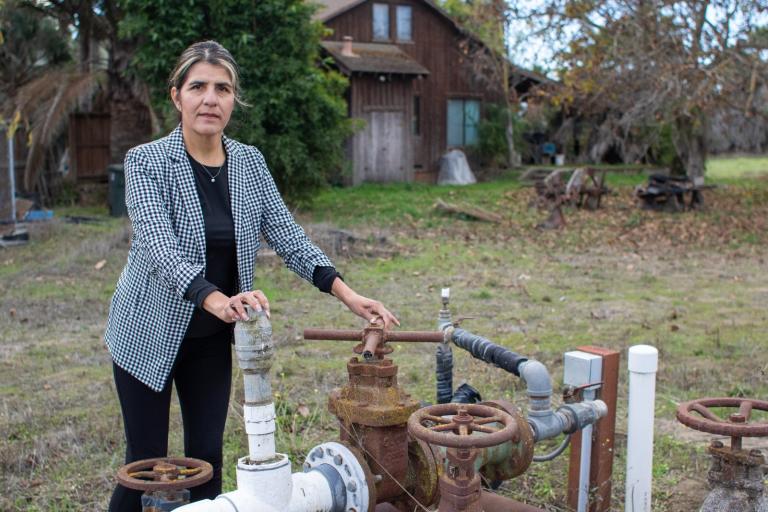Sarah Matsumoto is the GREEN Western Organizer for the Endangered Species Coalition. Based in Albuquerque, N.M., she works to protect wildlife and wildlands across the U.S. and especially in the West.

Monday, 9 Oct 2000
ALBUQUERQUE, N.M.
Monday mornings always remind me of a quote by E. B. White that I used to have hanging on my bedroom wall: “Every morning I awake torn between a desire to save the world and an inclination to savor it. This makes it hard to plan the day.” Starting a new week working to protect our country’s wildlife and wildlands, I am torn between the important work that I do and a distinct desire to call in sick so I can go explore the beautiful lands in New Mexico.
I did have a chance this weekend to savor the world a little and celebrate the beginning of fall, my favorite season in the Southwest. The days are still hot and blessed with bright blue, almost cloudless, skies; the sunsets are starting to turn the clouds and the mountains orangey-pink; and the nights are cool enough that you can fall asleep with the windows open. In Albuquerque this weekend, one of our fall traditions began: the annual balloon festival with hundreds of rainbow-colored hot-air balloons taking to the skies and people coming from across the country to see them and partake of our green chile breakfast burritos. I also celebrated a personal fall tradition this weekend, hiking with some friends into the Manzano Wilderness, through one of the Southwest’s largest stands of maples, turning yellow, orange, pink, and red.

Refreshed from a weekend enjoying New Mexico’s natural beauty, I settle down at my desk to save some of it. I am the GREEN Western Organizer for the Endangered Species Coalition. The Endangered Species Coalition (ESC), powered by GREEN (the GrassRoots Environmental Effectiveness Network), is a national network of over 400 diverse organizations working to protect and restore imperiled species and habitat. From environmental activists to church groups, from science associations to concerned individuals, the coalition is made up of groups as varied as the species we protect. Our mission is to both strengthen the Endangered Species Act and fend off the frequent attacks on endangered species protection.
The ESC exists primarily to represent local grassroots groups who are working to protect species and habitat in their regions, states, and towns. GREEN field staff are available to help with skills training, information gathering, coalition building, media work, and on-the-ground organizing on issues important to the coalition.
Here at the ESC, we had some very exciting news last week about a great endangered species bill in Congress. As readers may know, last Tuesday, Sen. Frank Lautenberg (D-N.J.) introduced the Endangered Species Recovery Act. (A companion bill in the House was introduced earlier this year.) This bill would strengthen the current Endangered Species Act of 1973.
This is an extremely exciting step for imperiled species of New Mexico, the West, and the rest of the country! While the original Endangered Species Act (ESA) is helping to recover many important species, such as the bald eagle, our national symbol, there are still others that are slipping through the cracks. Even with the ESA, we are faced with the greatest rate of extinction since the disappearance of the dinosaurs. Here in New Mexico, the Gila trout, the silvery minnow, the Mexican gray wolf, and the mesa verde cactus are heading toward extinction. Certainly, the ESA needs to be strengthened and this new legislation is a great step!

A Mexican gray wolf.
Photo: USFWS.
The goal of the Endangered Species Recovery Act (ESRA) is to recover, and eventually delist, the nation’s 1,233 species now considered endangered or threatened. The bill would strengthen the ESA by protecting species in a common-sense way. One of the greatest aspects of the ESRA is that it would make recovery of species, not just survival, the goal of all conservation efforts. It would also provide many programs for landowners, such as financial incentives for those who manage their land in ways that promote wildlife conservation.
Most of my day will be spent talking with papers across the West about the introduction of the ESRA and working with our local volunteers and member organizations to spread the word about this great bill. I’m also continuing my work getting activists in many different states (California, Montana, New Mexico, Nevada, Oregon, and Washington) to talk with their senators and representatives about the grassroots support for stronger endangered species legislation in the hopes that our congresspeople will cosponsor the ESRA.
In addition to working on national bills and campaigns, I also work with Endangered Species Coalition member organizations on local, statewide, and regional efforts to protect endangered species and the habitat they depend on. Maybe I will have a chance to talk about some of those local efforts later in the week.
At the moment, I have to stop staring out the window at hot-air balloons rising in front of the Sandia Mountains and get back to the nitty-gritty work of defending the Endangered Species Act and protecting our nation’s imperiled wildlife.

